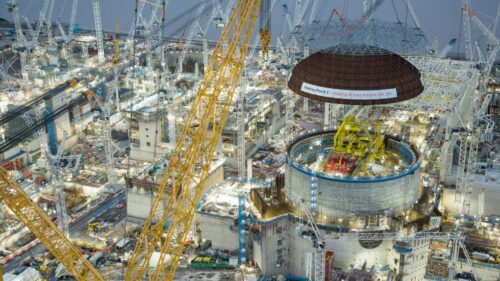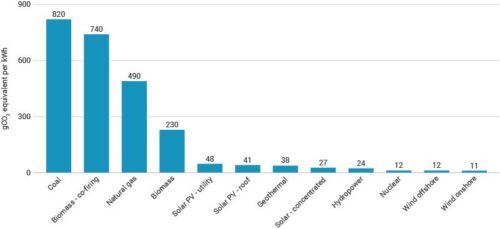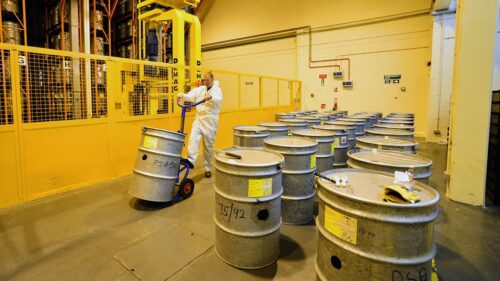

Nuclear energy’s contentious nature has garnered praise for its sustainability by some while also being considered a ticking time bomb by others. But what exactly is it, and why are we so divided about it? Nuclear energy is a powerful source of electricity generated through fission. It is a process in which atomic nuclei are split into several parts. A tremendous amount of energy is released in the form of heat and radiation, then converted into electricity. While it offers a more efficient and low-carbon alternative, concerns surrounding radioactive waste and its long-term sustainability continue to challenge the adoption of nuclear power. With a global shift towards sustainability and evergrowing energy demands, can nuclear power be the key to a cleaner future, or do the risks prove too significant?
Whilst existing nuclear power infrastructure has proven itself to be dependable in France, providing a source of cheap and clean electricity, during a time when energy prices and emissions have soared across the old continent, new nuclear projects in developed nations have faced significant hurdles. Characterised by their lengthy delays and excessive budget overruns, these projects have served as the primary deterrence against new developments, and for good reason. This is symbolised by the first new nuclear power station built in Britain in over 30 years, Hinkley Point C. The expected cost ballooned from £18bn to a hefty £46bn, and the project fell 4 years behind schedule. Such ignominious displays are not limited to the British Isles but are unfortunately commonplace across wealthy countries.

Figure 1: Domed roof was lifted onto Hinkley Point C’s first reactor
A recent report by the International Energy Agency (IEA) details how projects in the EU and the US have faced constant delays. This has led to extended construction times well above other power generation methods and large budget overruns. The rising costs of nuclear reactors may seem counterintuitive due to the mature nature of the technology, but a multitude of factors can explain this.
One such factor is the idiosyncratic nature of regulation across countries, preventing the use of off-the-shelf reactor solutions. Instead, extensive modifications must be made to satisfy the individual regulations of countries, resulting in higher costs, longer construction times, and a higher likelihood of delays. However, the more significant factor would be the inconsistent, start-stop nature of nuclear energy projects in these nations. The extended periods of time between projects result in the loss of expertise, technical knowledge, and skilled workforce in a phenomenon known as brain-drain. The outcome of this approach is the need it creates to retrain the workforce and rebuild the expertise every time a project is undertaken.
By avoiding the inefficiencies of this approach, countries such as South Korea and China have benefited greatly. These nations can buck the trend of long delays and cost overruns by using mature, off-the-shelf solutions and maintaining a nuclear industrial base. This can be achieved with consistent investment in new nuclear energy projects, greatly reducing complexity, uncertainty, construction time, and cost. The lower costs are reflected in the energy price, with the cost of nuclear energy in China being around US$70 per MW/h, compared to $105 in the US and $160 in the EU. As showcased by China, the high construction cost is not inherent to nuclear power but rather a result of policies and attitudes in countries with advanced economies. If willpower is present, cheap nuclear power does not have to remain a pipedream under the correct policy decisions.
A stable and continuous electricity supply is at the heart of the economy and reflects modern society’s reliance on electricity to power our cities. Baseload power is the minimum demand on an electrical grid and is traditionally satisfied by sources like coal and natural gas. However, fossil fuels are a major contributor to the global CO₂ emissions, with coal accounting for 41% and natural gas 21% in 2024. Ultimately signalling a need for cleaner energy alternatives. Nuclear power plants outperform the reliability of coal and natural gas plants, operating at maximum output more than 92% of the time during the year. Nuclear energy’s independence from weather conditions enables a stable and predictable power supply, making it an ideal source to meet baseload demands.

Figure 2: Average life-cycle carbon dioxide emissions for different electricity generators
Comparatively, renewable energy sources such as wind and solar have gained prominence from innovation and rising efficiency but face challenges due to their intermittent nature. The fluctuations in weather and time of day make wind and solar power inherently variable in their outputs, placing dependency on factors unfavourable for modern-day demands. The intermittency can disrupt grid stability, necessitating backup systems or storage to ensure a consistent electricity supply.
Recent advancements in battery storage options, such as grid-scale lithium-ion batteries, propel the feasibility of energy alternatives forward. However, they are not yet sufficient to maintain baseload requirements solely. A cause for concern is the lack of sustainability and variability in output for sustainable energy sources, which hinders its ability to keep up with baseload power requirements. Integrating nuclear energy into the power generation portfolio overcomes the limitations endured by current baseload sources while facilitating a more green approach.
When it comes to nuclear energy, waste management is essential for ensuring public and environmental safety. Public concerns surrounding nuclear waste often stem from past high-profile nuclear catastrophes. These concerns are valid, as finding a secure and permanent disposal site is a major issue. However, the industry has learned from past mistakes, and strict procedures have been implemented globally to handle and dispose of radioactive nuclear waste safely.
Low-level radioactive waste accounts for approximately 90% of the waste by volume and is typically disposed of by land-based disposal. For intermediate and high-level waste, the first step is responsible storage to allow the decay of radioactivity and heat dissipation. This process enhances safety and makes handling nuclear waste more manageable and safer. Countries worldwide use ponds or dry casks to store and allow nuclear waste to cool down, and specifically for high-level radioactive waste, it is usually stored for around 50 years.

Figure 3: Safe and secure storage of radioactive waste
The final step to safely dispose of the waste is deep underground disposal to prevent potential environmental or human health risks. Although the storage and disposal of waste can be a lengthy process, concerns about storing the quantity of waste are refuted by the fact that nuclear fuel is an efficient and energy-dense power source. On average, the waste from a single reactor used to supply electricity for a single person would be about the size of a brick – only 5 grams of which would be considered high-level waste.
Furthermore, 96% of fuel used to power nuclear reactors is recyclable, reducing the amount of waste produced. The generation of electricity, which would supply the needs of more than a million people, produces only 3 cubic metres of high-level waste per year, the majority of which can be recycled. In comparison, coal-fired power stations would produce approximately 300,000 tonnes of ash and more than 6 million tonnes of CO2 annually, demonstrating nuclear power’s efficiency and environmental advantage if done correctly.
When the atom was first split and the idea of nuclear burst into the scene, it was a breakthrough. A scientific tour de force that promised a revolution of infinite free energy. While environmental impact probably wasn’t a consideration back then, with the year-on-year effects of climate change only worsening, it certainly is today. The need to transition away from fossil fuels only becomes more urgent every day that passes. Despite the controversy, nuclear energy is our best chance of a carbon-free energy system. Nuclear power efficiently produces affordable green energy, a consistent base load while producing minimal amounts of easily manageable waste. Coupled with the right policies and support, nuclear energy could be the silver bullet for sustainable and reliable energy.
AndrewsSpeed, P. (2023). Nuclear Power in China: its role in national energy policy. Oxford Institute for Energy Studies; JSTOR. https://doi.org/10.2307/resrep47154
Bonneville Power Administration. (n.d.). Intermittent Renewable Energy. Www.bpa.gov. https://www.bpa.gov/energy-and-services/efficiency/demand-response/intermittent-renewable-energy
Casey, P. (2012, November 19). Rookie» Literally the Best Thing Ever: Retro-futurism. Www.rookiemag.com. https://www.rookiemag.com/2012/11/literally-the-best-thing-ever-retro-futurism/
Era. (2025, January 16). The Path to a New Era for Nuclear Energy – Analysis – IEA. IEA. https://www.iea.org/reports/the-path-to-a-new-era-for-nuclear-energy
Galindo, A. (2022, November 15). What Is Nuclear Energy? the Science of Nuclear Power. International Atomic Energy Agency; International Atomic Energy Agency. https://www.iaea.org/newscenter/news/what-is-nuclear-energy-the-science-of-nuclear-power
IChemE. (2024, January 26). Hinkley Point C could go £28bn over budget as EDF predicts further delays. Www.thechemicalengineer.com. https://www.thechemicalengineer.com/news/hinkley-point-c-could-go-28bn-over-budget-as-edf-predicts-further-delays/
IEA. (2023, July 11). Energy storage. IEA. https://www.iea.org/energy-system/electricity/grid-scale-storage
International Atomic Energy Agency. (2016, March 16). Abstracts Due 15 April: IAEA Conference on the Safety of Radioactive Waste Management. Iaea.org. https://www.iaea.org/newscenter/news/iaea-conference-on-the-safety-of-radioactive-waste-management
Johnston, I., & Millard, R. (2025, February 21). UK’s Hinkley Point C nuclear plant yet to attract new investors, says EDF boss. @FinancialTimes; Financial Times. https://www.ft.com/content/c546117d-1fbc-47c8-93a8-dd823311d2ac
JV. (2024). Fossil fuel CO2 emissions increase again in 2024. Global Carbon Budget. https://globalcarbonbudget.org/fossil-fuel-co2-emissions-increase-again-in-2024/
Liebman, A. (n.d.). What’s baseload power? Here’s a glossary of energy terms – ARENAWIRE. Australian Renewable Energy Agency; ARENAWIRE. https://arena.gov.au/blog/national-energy-market/
Office of Nuclear Energy. (2021, March 24). Nuclear Power Is the Most Reliable Energy Source and It’s Not Even Close. Energy.gov; Office of Nuclear Energy. https://www.energy.gov/ne/articles/nuclear-power-most-reliable-energy-source-and-its-not-even-close
Orano Group. (2024). All about used fuel processing and recycling. Www.orano.group. https://www.orano.group/en/unpacking-nuclear/all-about-used-fuel-processing-and-recycling
Rothwell, G. (2022). Projected electricity costs in international nuclear power markets. Energy Policy, 164, 112905. https://doi.org/10.1016/j.enpol.2022.112905
Şeyma Bozkaya, Onifade, S. T., & Duran, M. S. (2024). Nuclear energy utilization and the expectations of emission-reduction gains: Empirical evidence from economic trajectory of selected utilizing states. Progress in Nuclear Energy, 178, 105526–105526. https://doi.org/10.1016/j.pnucene.2024.105526
Slotta, D. (2024, January 3). Initial and revised construction costs of modern nuclear reactors operative in China in 2021. Statista; Daniel Slotta. https://www-statista-com.eu1.proxy.openathens.net/statistics/1356984/construction-cost-nuclear-reactors-china/
Statista Research Department. (2025, February 20). Household electricity prices worldwide in June 2024, by country. Openathens.net; Statista Research Department. https://www-statista-com.eu1.proxy.openathens.net/statistics/263492/electricity-prices-in-selected-countries/
Tani, S. (2024, November 30). Traders pay record premium for European gas next summer. @FinancialTimes; Financial Times. https://www.ft.com/content/a288628a-e789-4c6c-bb55-8c86ee0e8404
The Economist. (2023, November 30). China is building nuclear reactors faster than any other country. The Economist. https://www.economist.com/china/2023/11/30/china-is-building-nuclear-reactors-faster-than-any-other-country
World Nuclear Association. (2024, April 30). Storage and Disposal of Radioactive Waste – World Nuclear Association. World-Nuclear.org; World Nuclear Association. https://world-nuclear.org/information-library/nuclear-fuel-cycle/nuclear-waste/storage-and-disposal-of-radioactive-waste
Wright, R. (2025, February 10). Can the nuclear industry find a better way to build? @FinancialTimes; Financial Times. https://www.ft.com/content/5e563e3f-575d-4a90-bd46-4d0a3083f707
The CAINZ Digest is published by CAINZ, a student society affiliated with the Faculty of Business at the University of Melbourne. Opinions published are not necessarily those of the publishers, printers or editors. CAINZ and the University of Melbourne do not accept any responsibility for the accuracy of information contained in the publication.